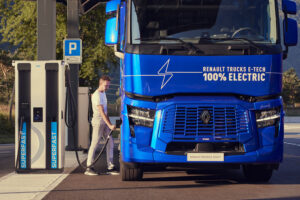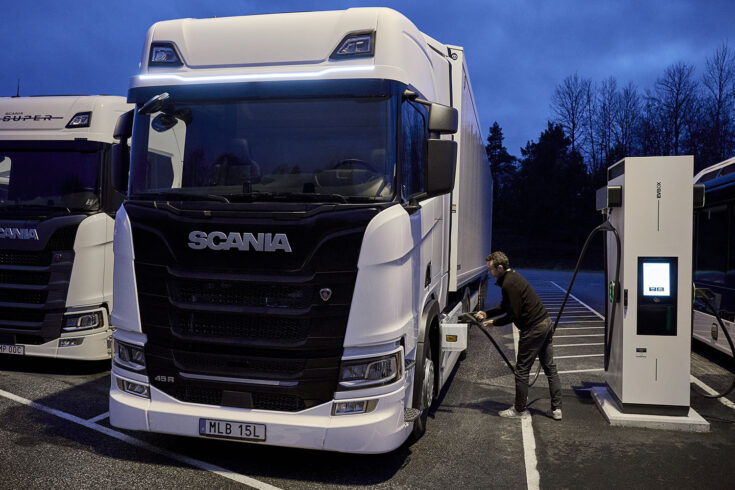Electric vehicle charging technology specialists, Voltempo, have brought together a significant and specialist consortium to demonstrate a range of use cases for transitioning from diesel to electric HGVs.
Heavy goods vehicles (HGVs) account for 18% of road transport emissions and 13% of nitrogen oxides levels, showing how important a change in powering these vehicles would be for the environment, as well as for operational and cost benefits too.
Although electric vehicle technology currently exists, there are still limitations that stand in the way of its widespread uptake, including driving range, vehicle availability, the speed of charging, and the availability of infrastructure.
eFreight 2030

Renault Trucks electric HGV charging.
Credit: Renault Trucks UK
The ‘eFreight 2030’ project will demonstrate how battery-electric HGVs can effectively replace conventional HGVs at scale on the UK road network, using a number of UK-built technologies to provide a true alternative vehicle solution that overcomes current hurdles.
The project uses next generation electric HGVs from leading manufacturers, coupled with innovative new range-extending trailer technology, and state-of-the-art 1MW charging hubs.
Focused on major trunk routes and ports, eFreight 2030 will help enable the upgrade of major charging hub infrastructure to support the wider uptake of electric HGVs in UK industry, as well as providing a data-led approach to the more strategic use of vehicles.
The nature of the project inevitably brings a range of environmental benefits. Not simply through the replacement of diesel vehicles with electric counterparts, but also in improving the underlying efficiency of the wider HGV network through greater route, timetable, driver hours and goods delivery planning through the software solution.
The project scope
The project is led by Voltempo, with support from a substantial consortium of expert companies from across vehicle manufacturers and operators, technology companies, researchers and data specialists.
Under the project, 100 electric HGVs will be in operation across a range of different uses, looking to prove the operational benefits of these vehicles, alongside publicly accessible charging hubs.
While most of these vehicles will be run by consortium members during the project’s duration, up to 10 will be available for fleets outside of the project to trial on a short-term basis. This forms part of the underlying goal to involve the wider industry in the uptake of electric HGVs.
Up to 32 1MW multi-bay charging stations will be installed at major ports, airports and major road routes, to provide the necessary infrastructure to support both common and more challenging HGV use cases. Meanwhile, a novel new in-trailer battery system will be tested on its effectiveness for dramatically increasing the range of these vehicles.
Alongside the vehicles and infrastructure, the project will utilise tailored software. This not only tracks the vehicles, their energy usage and any potential operational efficiencies, but forms a key part of building a data-led business case for the industry to justify a move to electric HGVs.
Aims and ambitions
The eFreight 2030 project has a number of key targets. As mentioned, the project aims to build a network of 32 charging bays and demonstrate not only their appropriateness for supporting the electric HGV drive, but also in their wider public use and their ability to provide sufficient power to complete the required multi-vehicle charging that will be needed.
As part of their installation, through the expertise within the consortium and Voltempo’s innovative technology, the project aims to reduce the grid connection time for hub infrastructure to between three and six months, down from the current nine to 12-month lead in times.
The Berkeley Bulldog e-trailer will also be an essential part of the eHGV demonstration, and the project will showcase its ability to add a further 300km to the range of a vehicle, without compromising the load capacity of the trailer, and with a charge time of below 30 minutes.
The use of 100 test vehicles throughout the project will be the starting point to demonstrate results that will enable a wider roll-out of the technology. The project aims to move quickly after the testing phase to facilitate 2,000 electric HGVs on UK roads by 2030, which would eliminate around 60 million litres of diesel fuel from use.
A final ambition centres around the objective for wider uptake across the industry. Michael Boxwell, Group Chief Executive Officer at Voltempo, commented:
The eFreight 2030 project has never been about simply the needs of the consortium members when it comes to success, there has always been a focus on revolutionising the industry for all involved.
It’s for this reason that data modelling and testing, not only within the 100 electric HGVs, but from the more than 16,000 trucks operated by our consortium members, is a key part of understanding their use and where electric vehicles can play the most significant role.
Our aim to reach out to the wider industry is also why we reserved 10 vehicles for short-term use by SMEs, to combat any cost restrictions that are creating barriers to their involvement in testing how electric HGVs could work for their business.
This project will help raise the profile of sustainable freight, demonstrating how routes can be more effectively planned, drivers can be kept more local to their homes, and environmental benefits can be achieved by all.
About the funding
This project is funded as part of the Zero Emission HGV and Infrastructure Demonstrator programme, announced in October 2023. The projects are funded by the Department for Transport and delivered in partnership with Innovate UK, with this programme providing £200 million across four projects.
The programme will enable large, five-year, on-road demonstrations of hydrogen fuel cell and battery electric zero emission HGVs, with these projects focusing on the largest HGVs. The programme will also support the government’s commitment to end sales of all new, non-zero emission HGVs by 2035 to 2040.
This project is just one example of how Innovate UK and its partners are investing to realise the vision for road freight in the Transport Vision 2050 strategy document. This sets out what the UK transport system may look like in 2050, and outlines the likely steps along the way to achieving this.
Innovate UK and its partners are currently investing around £700 million in the current three-year spending review period in transport programmes covering the pathways set out in the Transport Vision document.
Find out more about this project on YouTube: eFreight 2030: demonstrating the transition to electric HGVs.
Top image: Scania electric HGV charging. Credit: Scania GB

